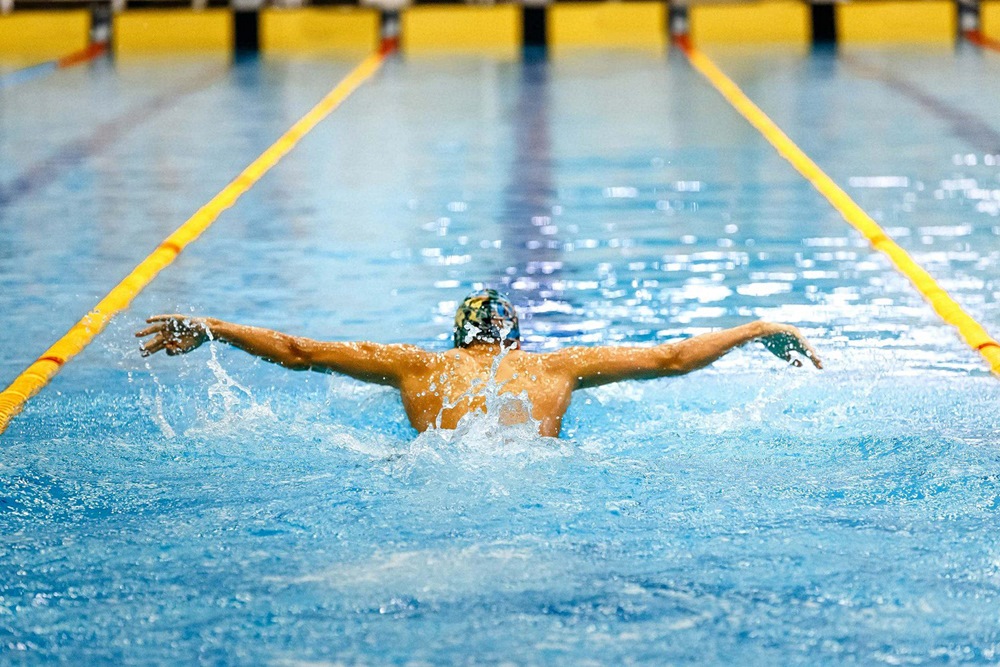Last Updated on: 18th December 2024, 12:31 pm
Swimming has evolved from a survival skill to a competitive sport and popular exercise. The choice of swimming style affects speed, efficiency, and enjoyment. Each style offers unique benefits and challenges, making it important to find one that aligns with your goals.
- Freestyle is known for speed and is often the first choice for beginners.
- Butterfly requires strength and coordination.
- Backstroke offers a unique perspective and ease of breathing.
- Breaststroke is leisurely and requires precise timing.
Choosing the right style can enhance your swimming experience and improve physical health. The best style is one that feels natural and meets your objectives.
Freestyle Swimming: Speed and Efficiency

Origins and Evolution
Freestyle, characterized by efficiency and speed, evolved from various strokes to the dominant front crawl. This evolution was driven by the need for maximum efficiency in competitive swimming.
Technical Breakdown
- Streamlined body position reduces resistance.
- Powerful, alternating arm movements provide propulsion.
- Coordinated breathing maintains pace and prevents exhaustion.
Advantages
Freestyle is the fastest swimming style due to its efficiency. It minimizes drag and maximizes momentum, making it ideal for long distances with less effort.
Ideal Scenarios for Using Freestyle
- Competitive racing, from sprints to marathons.
- Recreational swimming for fast navigation.
- Improving cardiovascular health.
Breaststroke: Technique and Endurance

Historical Significance of Breaststroke
Breaststroke is one of the oldest swimming styles, known for its distinctive technique. It has evolved while retaining its core principles.
Technical Breakdown
- Synchronized movements and breathing create a smooth motion.
- Whip-like kick and arm movement maximize efficiency.
- Integrated breathing establishes a rhythmic cycle.
Advantages
Breaststroke is low impact, making it suitable for those with physical limitations. It fosters a connection between mind, body, and water.
Ideal Scenarios for Using Breaststroke
- Leisurely swims and therapeutic sessions.
- Long-distance swimming for energy conservation.
Butterfly Stroke: Power and Intensity

The Creation and Development of the Butterfly Stroke
The butterfly stroke emerged in the 1930s, evolving from breaststroke to include simultaneous arm recovery and undulating body movement.
Technical Breakdown
- Coordinated body undulation mimics a dolphin’s movement.
- Powerful dolphin kick and two-arm pull provide intense propulsion.
Advantages
Butterfly builds upper body strength and enhances coordination, improving overall aquatic agility.
Challenges
Butterfly requires exceptional strength, timing, and endurance, making it challenging for even experienced swimmers.
Ideal Scenarios for Using Butterfly Stroke
- Competitive swimming for power and speed.
- Training to enhance strength and coordination.
Backstroke: Unique Perspectives

Uniqueness of Backstroke
Backstroke offers a skyward view and allows free breathing, distinguishing it from other strokes.
Technical Breakdown
Backstroke involves alternating arm movements, a flutter kick, and body rotation for efficient gliding.
Advantages
Backstroke eases breathing and promotes good back alignment, strengthening back muscles and improving posture.
Ideal Scenarios for Using Backstroke
Backstroke is ideal for relaxation, therapeutic exercise, and competitive swimming, offering a unique vantage point.
Backstroke combines health benefits, technical intrigue, and the joy of floating while gazing at the sky, catering to various needs and preferences.
Comparing Swimming Styles: Efficiency, Speed, and Use Cases

Efficiency Comparison
- Breaststroke is the most energy-efficient, ideal for endurance swimming.
Speed Comparison
- Freestyle is the fastest, minimizing resistance.
- Butterfly is fast but energy-demanding.
- Backstroke balances speed and relaxation.
- Breaststroke is the slowest with a methodical pace.
Use Cases
- Competitive Swimming: Freestyle and butterfly for speed; backstroke in medleys.
- Fitness Swimming: Freestyle for cardiovascular benefits.
- Rehabilitation: Breaststroke and backstroke are gentle on the body.
- Leisure Swimming: Style choice based on personal preference.
Understanding each swimming style helps swimmers choose one that aligns with their goals, whether for competition, fitness, recovery, or enjoyment.
Choosing the Right Swimming Style for You

- Choosing a swimming style depends on personal goals, physical condition, and swimming proficiency.
- Freestyle is accessible for beginners; butterfly suits those seeking a challenge.
- Breaststroke is preferred for joint concerns; backstroke for back strength and posture.
- Proficiency in one style can provide a foundation for others.
- Professional coaching helps refine technique and reduce injury risk.
- Experimenting with multiple styles enhances skills and ensures a well-rounded ability.
Experimenting with different styles enhances skills and provides a comprehensive fitness routine. Each style engages different muscles and offers varying benefits, contributing to overall fitness.
Wrapping It Up
Swimming styles offer diverse benefits and challenges. From freestyle’s speed to breaststroke’s rhythm, each style caters to different needs and goals. The choice of style reflects personal aspirations and physical condition, guided by professional advice.

